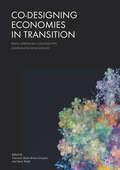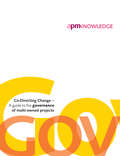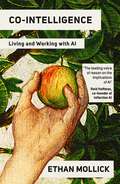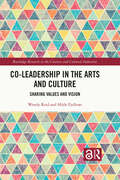- Table View
- List View
The Co-creative University: Evaluation, Expectations and Economic Policy Implications (Routledge Studies in the Economics of Innovation)
by Łukasz MamicaThe co-creative university has become the main driver of social and economic development stimulating internal (students and academics) and external creativity (companies and institutional environment) as well as cooperation in various areas (e.g. applied graduation theses, research projects, lifelong learning). Intended as a contribution to a better understanding of how universities create value in numerous areas, this book discusses the determinants of creativity and ways of stimulating it with a special focus on approaches and practical solutions relevant to teaching. Examples include problem-oriented student theses, which represent a successful combination of creativity with practical knowledge. Based on the findings of international surveys of students, the author offers an in-depth analysis of the differences between what they expect from universities and the degree to which their expectations are met. Comparing students’ opinions with those of employees of international corporations (working graduates) permitted the author to test the actual utility of selected aspects of university education. Regrettably, both groups of respondents gave low ratings to support for developing creativity, which should serve as a warning sign and inform future reforms at this level of education. This book is primarily targeted to those involved in education, policy-making, and socio-economic development. It provides a rich source of information for university managers on how to better fulfil their missions based on the idea of co-creativity. It also suggests how to improve the effectiveness of research and education in order to ensure that both can better respond to current development challenges.
Co-design and Social Innovation: Connections, Tensions and Opportunities (Routledge Studies in Social Enterprise & Social Innovation)
by Garth BrittonAlthough co-design has been practised in new service and product development for some years, it has only recently begun to appear in the burgeoning field of social innovation. It appears to be well-attuned to this new context, offering as it does an open-ended relational process to generate novel solutions to problems whose very definition seems to escape more conventional approaches. However, even less research attention has been paid to co-design than to social innovation. This book explores the potential of co-design as a social innovation process. It reviews the diverse theoretical and disciplinary foundations on which co-design is based. It proposes a framework for understanding co-design as a cohesive practice across the extremely broad scope of its potential applications. It explores appropriate approaches to governance and evaluation of co-design initiatives and outlines the key issues and limitations on its use. Although it is intended to provide a robust theoretical basis for researching co-design initiatives, it will also be of interest to anyone who is contemplating putting co-design into practice.
Co-design and Social Innovation: Connections, Tensions and Opportunities (Routledge Studies in Social Enterprise & Social Innovation)
by Garth BrittonAlthough co-design has been practised in new service and product development for some years, it has only recently begun to appear in the burgeoning field of social innovation. It appears to be well-attuned to this new context, offering as it does an open-ended relational process to generate novel solutions to problems whose very definition seems to escape more conventional approaches. However, even less research attention has been paid to co-design than to social innovation. This book explores the potential of co-design as a social innovation process. It reviews the diverse theoretical and disciplinary foundations on which co-design is based. It proposes a framework for understanding co-design as a cohesive practice across the extremely broad scope of its potential applications. It explores appropriate approaches to governance and evaluation of co-design initiatives and outlines the key issues and limitations on its use. Although it is intended to provide a robust theoretical basis for researching co-design initiatives, it will also be of interest to anyone who is contemplating putting co-design into practice.
Co-design for a New East Asia After the Crisis
by Young-HoKim HitoshiHirakawaEast Asia enjoyed a role as a growth center of the world economy from the 1960s until the currency and economic crisis of 1997. In 1993, the World Bank issued a report entitled "The East Asian Miracle: Economic Growth and Public Policy," in which the bank expressed its admiration for the region 's rapid economic develop ment. However, within only four years the region had fallen prey to the currency and economic crisis that spread outward from Thailand. In the midst of the crisis, many East Asian countries began at long last to cooperate with one another in order to cope with these unprecedented difficulties and to prevent another crisis. In fact, the East Asian region was an exception throughout the 1990s with re spect to regionalism. A surge of regionalism, which began in Europe in the second half ofthe 1980s, spread to North America and Latin America. However, the North east Asian region in particular, consisting of Japan, China (People's Republic of China), and Korea (Republic of Korea), did not participate in any kind of regional economic arrangements. Regional cooperation frameworks were limited to coun tries belonging to the Association of Southeast Asian Nations (ASEAN) and did not spread to the Northeast Asian region.
Co-Designers: Cultures of Computer Simulation in Architecture
by Yanni LoukissasDesigners employ a variety of tools and techniques for speculating about buildings before they are built. In their simplest form, these are personal thought experiments. However, embracing advanced computer simulations means engaging a network of specialized people and powerful machines. In this book, Yanni Alexander Loukissas demonstrates that new tools have profound implications for the social distribution of design work; computer simulations are technologies for collective imagination. Organized around the accounts of professional designers engaged in a high-stakes competition to redefine their work for the technological moment, this book explores the emerging cultures of computer simulation in architecture. Not only architects, but acousticians, fire safety engineers, and sustainability experts see themselves as co-designers in architecture, engaging new technologies for simulation in an evolving search for the roles and relationships that can bring them both professional acceptance and greater control over design. By illustrating how practices of simulation inform the social relationships and professional distinctions that define contemporary architecture, the book examines the cultural transformations taking place in design practice today.
Co-Designers: Cultures of Computer Simulation in Architecture
by Yanni LoukissasDesigners employ a variety of tools and techniques for speculating about buildings before they are built. In their simplest form, these are personal thought experiments. However, embracing advanced computer simulations means engaging a network of specialized people and powerful machines. In this book, Yanni Alexander Loukissas demonstrates that new tools have profound implications for the social distribution of design work; computer simulations are technologies for collective imagination. Organized around the accounts of professional designers engaged in a high-stakes competition to redefine their work for the technological moment, this book explores the emerging cultures of computer simulation in architecture. Not only architects, but acousticians, fire safety engineers, and sustainability experts see themselves as co-designers in architecture, engaging new technologies for simulation in an evolving search for the roles and relationships that can bring them both professional acceptance and greater control over design. By illustrating how practices of simulation inform the social relationships and professional distinctions that define contemporary architecture, the book examines the cultural transformations taking place in design practice today.
Co-Designing Economies in Transition: Radical Approaches in Dialogue with Contemplative Social Sciences (PDF)
by Vincenzo Mario Giorgino Zack WalshThis transdisciplinary volume puts forward proposals for wiser, socially just and sustainable socio-economic systems in transition. There is growing support for the view that the end of capitalism is around the corner, but on which conceptual and ethical basis can we interpret these times? With investigations into feminist economics, post-growth environmentalism, socio-technical digital design, collaborative and commons economics, the editors create a dialogue between radical knowledge/practices and contemplative social sciences to transgress disciplinary boundaries and implement new visions of reality. This important book challenges our ways of thinking and outlines a pathway for new research.Chapter 13 of this book is available open access under a CC BY 4.0 license at link.springer.com
Co-Designing Economies in Transition
by Vincenzo Mario Bruno Giorgino Zack WalshThis transdisciplinary volume puts forward proposals for wiser, socially just and sustainable socio-economic systems in transition. There is growing support for the view that the end of capitalism is around the corner, but on which conceptual and ethical basis can we interpret these times? With investigations into feminist economics, post-growth environmentalism, socio-technical digital design, collaborative and commons economics, the editors create a dialogue between radical knowledge/practices and contemplative social sciences to transgress disciplinary boundaries and implement new visions of reality. This important book challenges our ways of thinking and outlines a pathway for new research. Chapter 13 of this book is available open access under a CC BY 4. 0 license at link. springer. com
Co-Directing Change
by APM Governance Specific Interest GroupMulti-owned projects are on the increase, as businesses and other organisations capitalise on their complementary resources while diluting risk exposure. Written by the APM Governance Specific Interest Group, this guide enables an organisation’s directors to question how well its shared projects are governed and to decide where and at what level action is needed. Readers of this publication may also be interested in Directing Change, Sponsoring Change and Directing Agile Change
Co-Economy: Netzwerke und agile Organisationsstrukturen erfolgreich nutzen
by Claudia Pelzer Nora BurgardWie können und müssen Unternehmen die digitale Vernetzung für sich nutzen? Welchen Mehrwert bieten dabei Crowd-basierte Lösungen und kollaborative Innovationen? Antworten auf diese grundlegenden Fragen liefert dieses Buch. Die Autorinnen erklären, wieso und in welcher Form auch die bestehenden Business-Modelle, Arbeits- und Organisationsformen einem Wandel unterliegen. Sie erläutern fundiert und leicht verständlich, welche Tools die Netzwerk-Ökonomie hervorgebracht hat, welche Auswirkungen sie auf einzelne Branchen hat und wie die Umsetzung in die Praxis funktioniert. Zahlreiche Beispiele zeigen, wie schnell Veränderungen, Branchen-Innovationen und -Disruptionen unterschätzt werden und wie wichtig Offenheit und Agilität für Unternehmen sind – heute mehr denn je.
Co-Ed Understanding Business Environments
by Vivek SunejaFirst published in 2002. Routledge is an imprint of Taylor and Francis, an informa company.
Co-Ed Understanding Business Markets
by Vivek SunejaFirst published in 2002. Routledge is an imprint of Taylor and Francis, an informa company.
The Co-evolution of Commodity Flows, Economic Geography, and Emissions (Advances in Spatial Science)
by Kieran Donaghy Arash Beheshtian Ziye Zhang Benjamin Brown-SteinerThis book presents extensions to current commodity-flow models to analyze the economic and environmental impacts of recent structural changes, such as fragmentation of production and lengthening supply chains. The extensions enable augmented commodity-flow models to analyze the vulnerability of supply chains and regions to climate change and extreme weather events. The models allow the explicit treatment of trade in intermediate goods; the so-called “new economic geography” behavioral foundations for production and inter-industry and interregional trade; endogenous determination of capital investment and employment; and changes in emissions associated with production, consumption and freight movement. Presenting a modeling framework and simulations that are based on a thirty-year, spatial time-series of inter-industry and interstate trade in the US, this unique book is a valuable resource for regional scientists, economic geographers and transportation modelers, as well as environmental and atmospheric scientists.
Co-Evolution of Standards in Innovation Systems: The Dynamics of Voluntary and Legal Building Codes (Contributions to Management Science)
by Stefan N. GrösserMitigating climate change is one of the most profound challenges facing humankind. In industrialized countries, the residential housing sector produces roughly one-fourth of the greenhouse gas emissions. One solution to reduce these emissions is the availability of building codes that require high levels of energy efficiency. Given the current scientific knowledge, more research is needed to gain a proper systemic understanding of the underlying socio-economic and technical system. Such an understanding is crucial for developing high energy-efficiency standards because this system develops gradually over time and cannot be changed swiftly. This book creates a feedback-rich simulation model for analyzing the effects of different administrative policies on energy demand, the improvement of energy efficiency by means of building codes, and reductions in the greenhouse gas emissions. The dynamic model can contribute substantially to the discourse on energy policies and guide effective administrative interventions. The book will be a valuable resource for officials in the public energy administration, as well as researchers in the areas of innovation, diffusion processes, co-evolution, standardization, and simulation modelling.
Co-Evolution of Symbolic Species in the Financial Market: A Framework for Economic and Political Decision-Making
by Emil Dinga Camelia Oprean-Stan Cristina Roxana Tănăsescu Vasile Brătian Gabriela-Mariana IonescuThis book offers a systemic understanding of the evolutionary model of financial markets and their place with broader political economic systems. Through examining the co-evolutionary process, where the interplay between financial markets and society is highlighted, insight is provided into the concepts of growth, development, preference, information, and price. After outlining these core concepts, they are applied to co-evolution within financial markets to illustrate the mechanics that underpin economic systems. Binomial and trinomial co-evolution is then discussed in relation to financial market variables, preference and price in terms of symbolic utility, and logical economic modelling structures.This book presents a new research methodology based on a logical to approach economics that looks beyond historical and empirical economic frameworks. It will be relevant to students, researchers, and policymakers interested in financial economics.
Co-evolution Strategy Canvas
by Jiang Yong LuThis book discusses the problem that why entrepreneurs don’t have clear strategies in different phrases and how to solve it. The author uses the tools of human resource from inside and outside aspects to analyze the problem. What’s more, the author also discusses the problems from 4 dimensions, such as users, organizations, products and markets. Use the co-evolution strategy canvas to summarize solutions for different phrases of enterprises.
Co-Financing Hollywood Film Productions with Outside Investors: An Economic Analysis of Principal Agent Relationships in the U.S. Motion Picture Industry (Markt- und Unternehmensentwicklung Markets and Organisations)
by Kay H. HofmannOver the past two decades, investors from outside the motion picture industry have increasingly supplied equity to U.S. film productions. Today, these so-called co-financing arrangements are a common phenomenon in Hollywood. While the large studios usually carry out the operative tasks of movie production and distribution, the financiers as co-owners of the completed films have rights to the residual profits. Kay H. Hofmann analyzes the conflicts of interest and the organizational problems that may arise between the experienced major studios and investors with comparably low industry expertise. Guided by principal agent theory, the empirical analysis provides evidence for adverse selection and multiple aspects of moral hazard during production as well as distribution. Based on these findings, the author develops solutions that are not only relevant for current and future investors but also for studios and film producers who rely on the long-term availability of external funds.
Co-Innovation Competence: A Strategic Approach to Entrepreneurship in Regional Innovation Structures (Entrepreneurial Management und Standortentwicklung)
by Benedict C. DoepferThis work contributes to entrepreneurship research and offers practical implications for entrepreneurs and entrepreneurship promotors by critically analyzing a networked approach to value creation processes of young knowledge-intensive entrepreneurial firms and assessing precise strategies and tactics for entrepreneurial firms to exploit these structures. In this context the concept of co-innovation competence is introduced and empirically analyzed. Results indicate that entrepreneurs follow a specific approach towards networking minimizing transaction costs taking an on-demand-based perspective of networking. In this case entrepreneurs may relate to regional innovation promotors and also reach beyond regional structures to explore suitable partners and exploit structural holes.
Co-innovation Dynamics: The Management of Client-Supplier Interactions for Open Innovation
by Romaric Servajean-HilstOver the last 30 years, the pace of innovation has exploded while available resources have become increasingly scarce. Open Innovation is the solution, with client–supplier relationships being the main expedient. However, collaborating in innovation is full of obstacles, from uncertainties in innovation as a whole to difficulties with managing a business relationship. Co-innovation Dynamics, based on a deep-dive ethnographic inquiry enlightened by state-of-the-art management research, presents the daily life story of a collaborative innovation project. Also, based on two other qualitative and quantitative studies on co-innovation management, this book offers lessons and tips on how to manage the dynamics of collaborative innovation in the client–supplier relationship.
Co-innovation Dynamics: The Management of Client-Supplier Interactions for Open Innovation (Smart Innovation Set #20)
by Romaric Servajean-HilstOver the last 30 years, the pace of innovation has exploded while available resources have become increasingly scarce. Open Innovation is the solution, with client–supplier relationships being the main expedient. However, collaborating in innovation is full of obstacles, from uncertainties in innovation as a whole to difficulties with managing a business relationship. Co-innovation Dynamics, based on a deep-dive ethnographic inquiry enlightened by state-of-the-art management research, presents the daily life story of a collaborative innovation project. Also, based on two other qualitative and quantitative studies on co-innovation management, this book offers lessons and tips on how to manage the dynamics of collaborative innovation in the client–supplier relationship.
Co-Innovation Platforms: A Playbook for Enabling Innovation and Ecosystem Growth
by Tammy L. Madsen David CruickshankStrategies and practices for growing ecosystems are increasingly important in shaping industries and markets. Sustaining productive innovation is not just about you. It depends on others as well as your willingness and ability to collaborate effectively. This book is about how to use, as well as develop, a co-innovation platform to accelerate innovation and sustain ecosystem growth. It will show how you, your team and your organization can create and foster collaborative innovation among a diverse set of organizations that are located outside of your company’s hierarchy. A co-innovation platform provides an environment where firms can combine or recombine ideas to generate novel solutions. A distinctive feature of the co-innovation platform is its resource-open and hands-on approach to innovation. For many organizations, resource limitations, organizational obstacles and/or time constraints kill an idea before it takes shape. By providing access to demand-side and supply-side resources and capabilities to facilitate co-innovation, the platform solves this problem and shapes the ecosystem’s innovation trajectory from the ground up. This book provides strategic and practical guidance for orchestrating collaborative problem solving and ecosystem growth.
Co-Intelligence: Living and Working with AI
by Ethan Mollick'Co-Intelligence is the very best book I know about the ins, outs, and ethics of generative AI. Drop everything and read it cover to cover NOW' Angela DuckworthConsumer AI has arrived. And with it, inescapable upheaval as we grapple with what it means for our jobs, lives and the future of humanity. Cutting through the noise of AI evangelists and AI doom-mongers, Wharton professor Ethan Mollick has become one of the most prominent and provocative explainers of AI, focusing on the practical aspects of how these new tools for thought can transform our world. In Co-Intelligence, he urges us to engage with AI as co-worker, co-teacher and coach. Wide ranging, hugely thought-provoking and optimistic, Co-Intelligence reveals the promise and power of this new era.
Co-Leadership in the Arts and Culture: Sharing Values and Vision (Routledge Research in the Creative and Cultural Industries)
by Wendy Reid Hilde FjellværThis book is about co-leadership: A leadership practice and structure often found in arts organizations that consist of two or three executives who bridge the art and business divide at the top.Many practitioners recognize this phenomenon but the research on this topic is limited and dispersed. This book assembles a coherent overview and presents new insights of the field. While co-leadership is well institutionalized in the West, it is also criticized for management’s constraint of artistic autonomy and for its pluralism that dilutes leadership clarity. However, co-leadership also personifies the strategic objectives of art, audiences, organization, and community, by addressing plural logics – navigating the demands of artistic vision and organizational stability. It is an integrating solution. The authors investigate its specifics in the arts, including global practice and its interdisciplinary nature. The theoretical frame of plural leadership supports their empirical explorations of the dynamics within the co-leadership relationship and with organizational stakeholders. Data includes the voices of co-leaders, artists, staff, and board members from arts organizations in Canada and Norway. Their abductive reflection generates a stimulating research experience.By viewing co-leadership in action, not as a study of static theories, the book will appeal not only to students and researchers but also resonate with practitioners in arts and cultural management and assist them to work with co-leadership and to manage its tensions.Chapters 1 and 4 of this book are freely available as downloadable Open Access PDFs at http://www.taylorfrancis.com under a Creative Commons Attribution-Non Commercial-No Derivatives (CC-BY-NC-ND) 4.0 license.
Co-Leadership in the Arts and Culture: Sharing Values and Vision (Routledge Research in the Creative and Cultural Industries)
by Wendy Reid Hilde FjellværThis book is about co-leadership: A leadership practice and structure often found in arts organizations that consist of two or three executives who bridge the art and business divide at the top.Many practitioners recognize this phenomenon but the research on this topic is limited and dispersed. This book assembles a coherent overview and presents new insights of the field. While co-leadership is well institutionalized in the West, it is also criticized for management’s constraint of artistic autonomy and for its pluralism that dilutes leadership clarity. However, co-leadership also personifies the strategic objectives of art, audiences, organization, and community, by addressing plural logics – navigating the demands of artistic vision and organizational stability. It is an integrating solution. The authors investigate its specifics in the arts, including global practice and its interdisciplinary nature. The theoretical frame of plural leadership supports their empirical explorations of the dynamics within the co-leadership relationship and with organizational stakeholders. Data includes the voices of co-leaders, artists, staff, and board members from arts organizations in Canada and Norway. Their abductive reflection generates a stimulating research experience.By viewing co-leadership in action, not as a study of static theories, the book will appeal not only to students and researchers but also resonate with practitioners in arts and cultural management and assist them to work with co-leadership and to manage its tensions.Chapters 1 and 4 of this book are freely available as downloadable Open Access PDFs at http://www.taylorfrancis.com under a Creative Commons Attribution-Non Commercial-No Derivatives (CC-BY-NC-ND) 4.0 license.
The Co-Occurring Disorders Treatment Planner, with DSM-5 Updates (PracticePlanners)
by Arthur E. Jongsma Jr. Jack KlottThis timesaving resource features: Treatment plan components for 25 behaviorally based presenting problems Over 1,000 prewritten treatment goals, objectives, and interventions—plus space to record your own treatment plan options A step-by-step guide to writing treatment plans that meet the requirements of most insurance companies and third-party payors The Co-Occurring Disorders Treatment Planner provides all the elements necessary to quickly and easily develop formal treatment plans that satisfy the demands of HMOs, managed care companies, third-party payors, and state and federal review agencies. A critical tool for mental health professionals treating patients coping simultaneously with mental illness and serious substance abuse Saves you hours of time-consuming paperwork, yet offers the freedom to develop customized treatment plans Organized around 25 main presenting problems with a focus on treating adults and adolescents with alcohol, drug, or nicotine addictions, and co-occurring disorders including depression, PTSD, eating disorders, and ADHD Over 1,000 well-crafted, clear statements describe the behavioral manifestations of each relational problem, long-term goals, short-term objectives, and clinically tested treatment options Easy-to-use reference format helps locate treatment plan components by behavioral problem Includes a sample treatment plan that conforms to the requirements of most third-party payors and accrediting agencies (including HCFA, JCAHO, and NCQA)



















